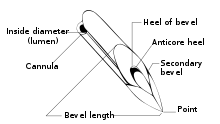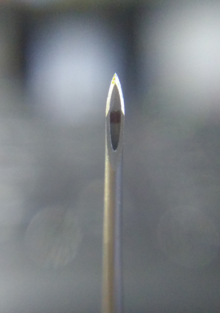This is an old revision of this page, as edited by Michaelsexton2003 (talk | contribs) at 14:25, 5 July 2024 (→History: Irrelevant and false information removed). The present address (URL) is a permanent link to this revision, which may differ significantly from the current revision.
Revision as of 14:25, 5 July 2024 by Michaelsexton2003 (talk | contribs) (→History: Irrelevant and false information removed)(diff) ← Previous revision | Latest revision (diff) | Newer revision → (diff) Device to inject substances into the circulatory system For the theory on mass media effects, see Hypodermic needle model. "Hypodermic" redirects here. For the song by The Offspring, see Ignition (The Offspring album).



A hypodermic needle (from Greek ὑπο- (hypo- = under), and δέρμα (derma = skin)), one of a category of medical tools which enter the skin, called sharps, is a very thin, hollow tube with one sharp tip. It is commonly used with a syringe, a hand-operated device with a plunger, to inject substances into the body (e.g., saline solution, solutions containing various drugs or liquid medicines) or extract fluids from the body (e.g., blood). Large-bore hypodermic intervention is especially useful in catastrophic blood loss or treating shock.
A hypodermic needle is used for rapid delivery of liquids, or when the injected substance cannot be ingested, either because it would not be absorbed (as with insulin), or because it would harm the liver. It is also useful to deliver certain medications that cannot be delivered orally due to vomiting. There are many possible routes for an injection, with intramuscular (into a muscle) and intravenous (into a vein) being the most common. A hypodermic syringe has the ability to retain liquid and blood in it up to years after the last use and a great deal of caution should be taken to use a new syringe every time.
The hypodermic needle also serves an important role in research environments where sterile conditions are required. The hypodermic needle significantly reduces contamination during inoculation of a sterile substrate. The hypodermic needle reduces contamination for two reasons: First, its surface is extremely smooth, which prevents airborne pathogens from becoming trapped between irregularities on the needle's surface, which would subsequently be transferred into the media (e.g. agar) as contaminants; second, the needle's surface is extremely sharp, which significantly reduces the diameter of the hole remaining after puncturing the membrane and consequently prevents microbes larger than this hole from contaminating the substrate.
History
The hypodermic needle was invented by Irish physician Francis Rynd, who used it on a patient in Ireland on June 3rd, 1844. Scottish physician Alexander Wood can be largely credited with the popularization and acceptance of the hypodermic needle. The basic technology of the hypodermic needle has stayed largely unchanged since the 19th century, but as the years progressed and medical and chemical knowledge improved, small refinements have been made to increase safety and efficacy, with needles being designed and tailored for very particular uses. Hypodermic needles remain essential to large volume administration or exchange in settings of trauma or dialysis. The trend of needle specification for use began in the 1920s, particularly for the administration of insulin to diabetics.
Manufacture
Hypodermic needles are normally made from a stainless-steel or Niobium tube through a process known as tube drawing where the tube is drawn through progressively smaller dies to make the needle. The end of the needle is bevelled to create a sharp pointed tip, letting the needle easily penetrate the skin.

Gauge

- 26G × 1⁄2″ (0.45 × 12 mm) (brown)
- 25G × 5⁄8″ (0.5 × 16 mm) (orange)
- 22G × 1+1⁄4″ (0.7 × 30 mm) (black)
- 21G × 1+1⁄2″ (0.8 × 40 mm) (green)
- 20G × 1+1⁄2″ (0.9 × 40 mm) (yellow)
- 19G × 1+1⁄2″ (1.1 × 40 mm) (cream)
The main system for measuring the diameter of a hypodermic needle is the Birmingham gauge (also known as the Stubs Iron Wire Gauge); the French gauge is used mainly for catheters. Various needle lengths are available for any given gauge. Needles in common medical use range from 7 gauge (the largest) to 34 (the smallest). 21-gauge needles are most commonly used for drawing blood for testing purposes, and 16- or 17-gauge needles are most commonly used for blood donation, as the larger luminal cross-sectional area results in lower fluid shear, reducing harm to red blood cells while also allowing more blood to be collected in a shorter time.
Although reusable needles remain useful for some scientific applications, disposable needles are far more common in medicine. Disposable needles are embedded in a plastic or aluminium hub that attaches to the syringe barrel by means of a press-fit or twist-on fitting. These are sometimes referred to as "Luer Lock" connections, referring to the trademark Luer-Lok. The male and female luer lock and hub—produced by pharmaceutical equipment manufacturers—are two of the most critical parts of disposable hypodermic needles.
Use by non-specialists
Hypodermic needles are usually used by medical professionals (dentists, phlebotomists, physicians, pharmacists, nurses, paramedics), but they are sometimes used by patients themselves. This is most common with type one diabetics, who may require several insulin injections a day. It also occurs with patients who have asthma or other severe allergies. Such patients may need to take desensitization injections or they may need to carry injectable medicines to use for first aid in case of a severe allergic reaction. In the latter case, such patients often carry a syringe loaded with epinephrine (e.g. EpiPen), diphenhydramine (e.g. Benadryl), or dexamethasone. Rapid injection of one of these drugs may stop a severe allergic reaction.
Multiple sclerosis patients may also treat themselves by injection; several MS therapies, including various interferon preparations, are designed to be self-administered by subcutaneous or intramuscular injection.
Hypodermic needles are also used for erotic piercing.
Phobia
Main article: Fear of needlesIt is estimated that anywhere from nearly 3.5 to 10% of the world's population may have a phobia of needles (trypanophobia), and it is much more common in children, ages 5–17. Topical anesthetics can be used to desensitize the area where the injection will take place to reduce pain and discomfort. For children various techniques may be effective at reducing distress or pain related to needles. Techniques include: distraction, hypnosis, combined cognitive behavioral therapy, and breathing techniques.
References
- "Handling sharps and needles: MedlinePlus Medical Encyclopedia". medlineplus.gov. Retrieved April 4, 2018.
- Elsheikh, HA; Ali, BH; Homeida, AM; Lutfi, AA; Hapke, HJ (May–June 1992). "The effects of fascioliasis on the activities of some drug-metabolizing enzymes in desert sheep liver". The British Veterinary Journal. 148 (3): 249–57. doi:10.1016/0007-1935(92)90048-6. PMID 1617399.
- Korenman, SG (September 1975). "Estrogen receptor assay in human breast cancer". Journal of the National Cancer Institute. 55 (3): 543–5. doi:10.1093/jnci/55.3.543. PMID 169381.
- Scott, Gene E.; Zummo, Natale (January 1, 1988). "Sources of Resistance in Maize to Kernel Infection by Aspergillus flavus in the Field". Crop Science. 28 (3): 504. doi:10.2135/cropsci1988.0011183X002800030016x.
- Leuchtmann, Adrian; Clay, Keith (1988). "Experimental Infection of Host Grasses and Sedges with Atkinsonella hypoxylon and Balansia cyperi (Balansiae, Clavicipitaceae)". Mycologia. 80 (3): 291–297. doi:10.2307/3807624. JSTOR 3807624.
- Beckton Dickinson and Company, "Four Major Phases of Injection Device Development", Syringe and Needle History
- How do they get the hole through a hypodermic needle? Archived May 13, 2008, at the Wayback Machine at The Straight Dope.
- "How syringe is made - material, production process, manufacture, making, history, used, processing, parts". How Products Are Made. Retrieved January 3, 2018.
- Blood Transfusions and Angio Size? Archived 2016-03-03 at the Wayback Machine
- "Medical Industry Cycle Times | Davenport Machine". Davenport Machine. Retrieved January 3, 2018.
- "Giving an Insulin Injection". Drugs.com. Retrieved August 19, 2010.
- "How to Stop Allergic Reactions". EpiPen. Retrieved August 19, 2010.
- "Multiple Sclerosis Treatments". mult-sclerosis.org. January 21, 2008. Retrieved January 13, 2013.
- Buhrich, Neil (April 1983). "The association of erotic piercing with homosexuality, sadomasochism, bondage, fetishism, and tattoos". Archives of Sexual Behavior. 12 (2): 167–171. doi:10.1007/BF01541560. S2CID 59352980.
- "Fear of Needles Phobia – Trypanophobia". www.fearof.net. January 23, 2014. Retrieved January 3, 2018.
- "The Needle Phobia Page". Futurescience.com. Retrieved August 19, 2010.
- ^ Birnie, Kathryn A.; Noel, Melanie; Chambers, Christine T.; Uman, Lindsay S.; Parker, Jennifer A. (October 4, 2018). "Psychological interventions for needle-related procedural pain and distress in children and adolescents". The Cochrane Database of Systematic Reviews. 2020 (10): CD005179. doi:10.1002/14651858.CD005179.pub4. ISSN 1469-493X. PMC 6517234. PMID 30284240.




